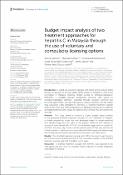Options
Budget Impact Analysis Of Two Treatment Approaches For Hepatitis C In Malaysia Through The Use Of Voluntary And Compulsory Licensing Options
Journal
Frontiers in Public Health
ISSN
2296-2565
Date Issued
2023
Author(s)
Amirah Azzer
Universiti Sains Islam Malaysia
Maznah Dahlui
Rosmawati Mohamed
Scott Alexander McDonald
Hafiz Jaafar
Universiti Sains Islam Malaysia
Fatiha Hana Shabaruddin
DOI
10.3389/fpubh.2023.1114560
Abstract
Introduction: A scaled-up treatment cascade with direct-acting antiviral (DAA therapy is necessary to achieve global WHO targets for hepatitis C virus (HCV)
elimination in Malaysia. Recently, limited access to sofosbuvir/daclatasvir (SOF/DAC) is available through compulsory licensing, with access to sofosbuvir/velpatasvir (SOF/VEL) expected through voluntary licensing due to recent agreements. SOF/VEL has superior clinical outcomes but has higher
drug acquisition costs compared to SOF/DAC. A stratified treatment cascade might be the most cost-e cient approach for Malaysia whereby all HCV patients
are treated with SOF/DAC except for patients with cirrhosis who are treated with SOF/VEL.
Methods: This study aimed to conduct a 5-year budget impact analysis of the proposed stratified treatment cascade for HCV treatment in Malaysia. A disease progression model that was developed based on model-predicted HCV epidemiology data was used for the analysis, where all HCV patients in scenario A were treated with SOF/DAC for all disease stages while in scenario B, SOF/DAC was used only for non-cirrhotic patients and SOF/VEL was used for the cirrhotic patients. Healthcare costs associated with DAA therapy and disease stage monitoring were included to estimate the downstream cost implications.
Results: The stratified treatment cascade with 109 in Scenario B was found to be cost-saving compared to Scenario A. The cumulative savings for the stratified
treatment cascade was USD 1.4 million over 5 years.
Discussion: A stratified treatment cascade with SOF/VEL was expected to be cost-saving and can result in a budget impact reduction in overall healthcare
expenditure in Malaysia.
elimination in Malaysia. Recently, limited access to sofosbuvir/daclatasvir (SOF/DAC) is available through compulsory licensing, with access to sofosbuvir/velpatasvir (SOF/VEL) expected through voluntary licensing due to recent agreements. SOF/VEL has superior clinical outcomes but has higher
drug acquisition costs compared to SOF/DAC. A stratified treatment cascade might be the most cost-e cient approach for Malaysia whereby all HCV patients
are treated with SOF/DAC except for patients with cirrhosis who are treated with SOF/VEL.
Methods: This study aimed to conduct a 5-year budget impact analysis of the proposed stratified treatment cascade for HCV treatment in Malaysia. A disease progression model that was developed based on model-predicted HCV epidemiology data was used for the analysis, where all HCV patients in scenario A were treated with SOF/DAC for all disease stages while in scenario B, SOF/DAC was used only for non-cirrhotic patients and SOF/VEL was used for the cirrhotic patients. Healthcare costs associated with DAA therapy and disease stage monitoring were included to estimate the downstream cost implications.
Results: The stratified treatment cascade with 109 in Scenario B was found to be cost-saving compared to Scenario A. The cumulative savings for the stratified
treatment cascade was USD 1.4 million over 5 years.
Discussion: A stratified treatment cascade with SOF/VEL was expected to be cost-saving and can result in a budget impact reduction in overall healthcare
expenditure in Malaysia.
File(s)
Loading...
Name
Budget impact analysis of two treatment approaches for hepatitis C in Malaysia through the use of voluntary and compulsory licensing options
Type
main article
Size
189.03 KB
Format
Adobe PDF
Checksum
(MD5):1dd29eed1c4c9f3103c5ab9750543742